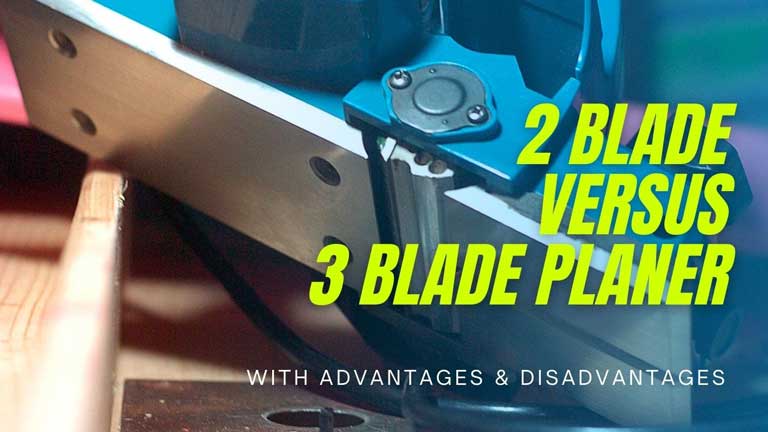Are you confused in deciding whether to choose a 2-blade planer or a 3-blade planer? Well, you won’t remain confused after reading this. Selecting the best wood planer for the right wood is quite challenging, especially when you are stuck between 2 blade and 3 blade types. So, we have put our hands together to make your job easy and effortless.
The article comprises of a detailed comparative analysis on 2 blades and 3 blades planer. Plus, you will learn the pros and cons that are shared between these two types almost equally. So, without any further ado, let’s read on-

Differences Between 2-Blades and 3-Blade Planer
The most common difference between the two is that a 2-blades planer is used to taper softwood, whereas a 3-blades planer is used to taper hardwood.
3-blades are claimed to be more powerful, and they can make deeper by finely smoothing out the hardwood. On the other hand, 2-blade planers are less powerful and are used for smoothing and cutting softwood.
Here are some of the common things between these two before we dive into the comparative analysis-
The Good
- It easily tapers the wood.
- Both can be replaced.
- Durable.
Not So Good
- They get blunt with time.
- Need to be replaced repeatedly.
Here comes the comparative analysis on 2 blade planner vs 3 blade planner-
Advantages of 2 Blade Planer
To Cut Softwood:
If you are searching for a proper planer that can cut softwood like pine, cedar, redwood then, 2-blades make your job easier.
Easy Replacement:
If you feel that re-sharpening and replacing the blades is a tedious task, no need to worry about it. 2-blades in any wood-aligning machines are easily removable as they are enclosed in a cutter head using adjustable knobs. Therefore, removing and replacing 2-blades is never a hassle.
Longevity:
Many customers who buy the cutters always look for blades’ longevity. Well, if you are one of those, then let us assure you that 2-blades can be used for the long-term. However, you need to check whether they are made with high-quality materials or not. For example, many customers came back with the reviews that blades made with steel and carbide were more productive than the knives made with local metals.
High Speed:
When it comes to the number of knives in a planer, many people think number dictates quality. If there are more blades, then woodworking would be a piece of cake. However, this is not true. A fewer number never defines the efficacy of the product. Many machines equipped with fewer blades are designed to work at high speeds.
Disadvantages of a 2 Blade Planer
Well, every good has a bad. So let us tell you some of the cons that you might face before you buy a 2-knife planer.
More Power Is Needed:
When there are fewer workers to do a task, the workers’ power consumption increases. The same is the case with a 2-blade planer. As they are low in number, so more power is required for them to function.
Few Strokes:
Tapering process with 2-blade planers is easy. However, if you want the blades to cut wood deeply, then it can be tough. With blunt blades, chatter marks on the wood become common.
Read Also: How to Choose a Budget Table Saw
Advantages of 2 Blade Planer
Fine Strokes:
As compared to a 2-blade planer, these are the ones that are most commonly in the top bench-top planer. They provide you with a tremendous advantage as due to the greater number of blades, you can achieve fine strokes. The end result of your work is quite pleasing when you use these blades.
For Hardwoods:
If you are looking to taper and smoothen hardwoods, then 3-blade planers make your job easy as the sharp edges can go deeper into the wood piece. Hence, more blades can cut more inches as compared to 2-blade planers.
Most Preferred:
Most industrial workers prefer 3-blades as they work for a longer-term and are effective with high or low speeds both. On the other hand, many customers have given positive reviews as they claim that the more the blades, the more the strokes.
Read Also: How to Pick a Full Size Wood Lathe
Disadvantages of 3 Blade Planer
Replacing The Blades:
Changing the blades can be challenging for many workers. As you increase the number of blades, replacing them with new ones requires skill too. While these knives provide you with easy and quick work, they can become blunt with time.
To check whether your planer’s blades have become blunt or not, look out for some symptoms shown by the machine. If the sound of your planer has become quite harsh or loud from before, then check out the sharpness of your blades.
Conclusion
All in all, both blades are widely used in the woodworking industry. One tip for deciding between the two is to see whether you are working on hardwood or softwood. If you want to taper the softwood, then choose a 2-blade planer.
Leave a Reply